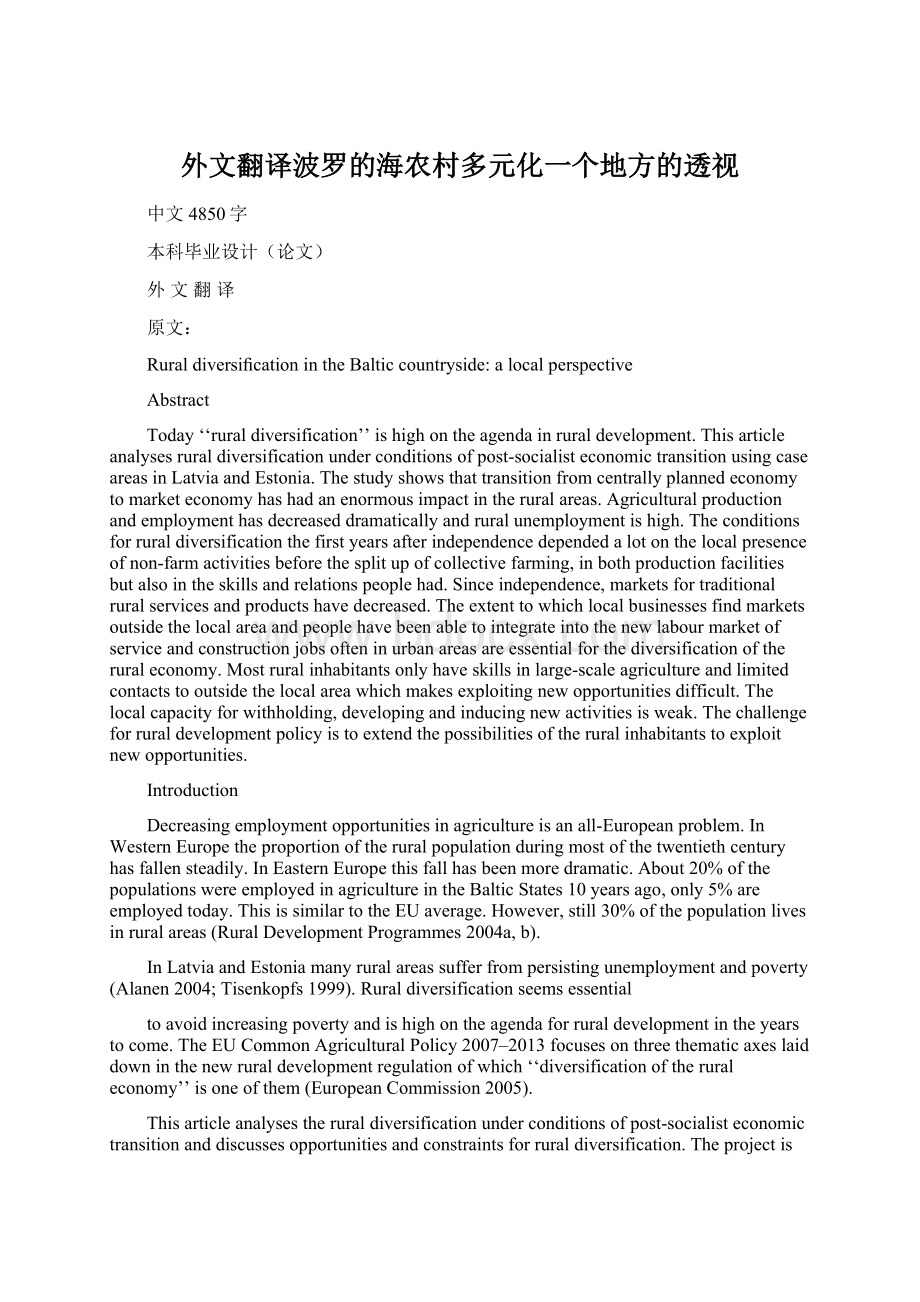外文翻译波罗的海农村多元化一个地方的透视Word文件下载.docx
《外文翻译波罗的海农村多元化一个地方的透视Word文件下载.docx》由会员分享,可在线阅读,更多相关《外文翻译波罗的海农村多元化一个地方的透视Word文件下载.docx(10页珍藏版)》请在冰豆网上搜索。

原文:
RuraldiversificationintheBalticcountryside:
alocalperspective
Abstract
Today‘‘ruraldiversification’’ishighontheagendainruraldevelopment.Thisarticleanalysesruraldiversificationunderconditionsofpost-socialisteconomictransitionusingcaseareasinLatviaandEstonia.Thestudyshowsthattransitionfromcentrallyplannedeconomytomarketeconomyhashadanenormousimpactintheruralareas.Agriculturalproductionandemploymenthasdecreaseddramaticallyandruralunemploymentishigh.Theconditionsforruraldiversificationthefirstyearsafterindependencedependedalotonthelocalpresenceofnon-farmactivitiesbeforethesplitupofcollectivefarming,inbothproductionfacilitiesbutalsointheskillsandrelationspeoplehad.Sinceindependence,marketsfortraditionalruralservicesandproductshavedecreased.Theextenttowhichlocalbusinessesfindmarketsoutsidethelocalareaandpeoplehavebeenabletointegrateintothenewlabourmarketofserviceandconstructionjobsofteninurbanareasareessentialforthediversificationoftheruraleconomy.Mostruralinhabitantsonlyhaveskillsinlarge-scaleagricultureandlimitedcontactstooutsidethelocalareawhichmakesexploitingnewopportunitiesdifficult.Thelocalcapacityforwithholding,developingandinducingnewactivitiesisweak.Thechallengeforruraldevelopmentpolicyistoextendthepossibilitiesoftheruralinhabitantstoexploitnewopportunities.
Introduction
Decreasingemploymentopportunitiesinagricultureisanall-Europeanproblem.InWesternEuropetheproportionoftheruralpopulationduringmostofthetwentiethcenturyhasfallensteadily.InEasternEuropethisfallhasbeenmoredramatic.About20%ofthepopulationswereemployedinagricultureintheBalticStates10yearsago,only5%areemployedtoday.ThisissimilartotheEUaverage.However,still30%ofthepopulationlivesinruralareas(RuralDevelopmentProgrammes2004a,b).
InLatviaandEstoniamanyruralareassufferfrompersistingunemploymentandpoverty(Alanen2004;
Tisenkopfs1999).Ruraldiversificationseemsessential
toavoidincreasingpovertyandishighontheagendaforruraldevelopmentintheyearstocome.TheEUCommonAgriculturalPolicy2007–2013focusesonthreethematicaxeslaiddowninthenewruraldevelopmentregulationofwhich‘‘diversificationoftheruraleconomy’’isoneofthem(EuropeanCommission2005).
Thisarticleanalysestheruraldiversificationunderconditionsofpost-socialisteconomictransitionanddiscussesopportunitiesandconstraintsforruraldiversification.TheprojectisanexploratorystudyintohowpeoplemakealivingandruralbusinessdevelopmentintwostudyregionsinLatviaandEstoniarespectively.
Theoreticalbackgroundandapproach
Indiversificationstudiesthecentreofattentionisdominantlythefarmhouseholdanditsabilitiesforfindingnewactivitiesandemployment.Therearetwotypesofactivities;
‘‘farmdiversification’’whichareon-farmactivitiesliketourismactivitiesoralternativefarmproductionand‘‘employmentdiversification’’whichisemploymentawayfromthefarm(Brydenetal.1992;
Chaplinetal.2004).Policymakersassumethat‘‘farmdiversification’’makesasignificantcontributiontoruraldevelopment.Alternativeactivitiesonfarmsareexpectedtohelpabsorbingsomeoftheexcessfarmlabour,alleviatepovertyandcontributetothedevelopmentofemploymentinruralareas(e.g.CouncilRegulation1999).Thefundingfor‘‘diversification’’withintheEUfocusesdominantlyonfarmdiversificationstimulatingtourismactivitiesandalternativefarmproductsatindividualfarms.
However,mostempiricalstudiesstillshowsthatfarmdiversificationaresmall-scaleactivitiesrelatedtoconventionalagriculturesuchasmachineryservicesandaddlittleincomes.‘‘Employmentdiversification’’ismuchmorewidespread(e.g.McNally2001).
Asmyfocusisruraldevelopment,myworkingdefinitionof‘‘ruraldiversification’’andthe‘‘nonfarmeconomy’’alsoincludesthebroaderruraleconomynotconfinedtoagricultureandthefarmhousehold.SomeruralareasinWesternEurope,particularlyaroundcitiesandpopularresorts,haveexperiencedanincreaseinpopulationandeconomicactivitiesnotinvolvedorrelatedtothefarmsector.Ithasoftenbeenconnectedtoanincreasingmovementofpeople,touristsandinvestmentsfromurbantoruralareas.Thisobservedtrendhasbeendescribedas
the‘‘urban-ruralshift’’orthe‘‘ruralturnaround’’(e.g.Murdochetal.2003;
North1998).
Thetransitionanddiversification
Researchintoruralissuesinpost-socialistcountrieshasmainlyfocusedonagriculturalrestructuring.Thefollowingpartexaminestheemergingresearchonpost-socialistruralchangeandtriestopointtofeaturesthatcharacterisetheruralareasintransitionandareimportantfortheunderstandingofdiversification.
Thefarmhousehold
ManysmallfarmsareacommonfeatureintheEasternEuropeancountrysidetoday.Thesocialistagriculturalsystemcomprisedoflarge-scaleagriculturalenterprisesandsmallhouseholdplotsthatfarmworkerscultivated.Duringthetransitionlandhasbeenrestitutedtoformerownersandprivatisedbyfarmworkers.TheaimoftherestitutionoflandwasintheBalticcountriesbasedontheideaofcreatingfamilyfarmssimilartothetraditionalWesternEuropeanmodel,however,the‘‘familyfarms’’,aretoday,uncommon.Adualstructureoffarmshasre-emerged;
large-scaleprivatised,oftencorrespondingtotheformersocialistfarms,andsmallhouseholdfarmsdominatinglyorientedtowardsself-subsistence.Alsomanyurbandwellersreceivedlandbackinrestitutionwhichmostoftenislefttogrowwild(Baldocketal.2001).
Theruralbusiness
Inthepost-socialistcountryside,theruralbusinessactivitiesotherthanfarmingcanbedividedintoprivatisedenterprisesandselfemployedservicebusinesses.Non-agriculturalproductionlikeprocessingplants,distilleriesandbakerieswereconnectedtothelargefarms.Suchunitshavebeencalledthe‘‘resilientunits’’(Andor1997)becausewhilethelargefarmshaveclosed,theyhaveoftencontinuedtheiroperations,althoughatamuchlowerlevelofactivitythanbefore(Nikula2004).
Theruralpopulation
Characteristicforthepost-socialistcountriesisthatalargershareofthepopulationlivesinruralareasthaninWesternEurope.‘‘Underurbanisation’’isoftenemphasisedasacentralfeatureofsocialistrural–urbanrelations(Szelenyi1996).Underurbanisationmeansthathousingconstructioninurbanareasdidnotkeeppacewithindustrialdevelopment.Workerscontinuedtoliveinvillageswheretheyalsocouldbenefitfromplotfarmingwhilecommutingtowork.Thisgroupofpeoplehasbeencalledthe‘‘workerpeasants’’(Andor1997).Theruralareashad,however,apopulationthatwasalmostentirelymadeupoflocalfarmersandworkersandtheredidnotexistanex-urban‘‘middleclass’’group.
Theregionaldifferences
AdistinctioninCEEC-literatureisoftenmadebetweenformer‘‘agriculturalregions’’and‘‘industrialregions’’(Raagmaa1997;
Swain2000).Intraditionallyheavilyindustrialisedregionsindustrieshaveoftenclosedandtherearefewemploymentopportunities.AgriculturalregionswereoftenspecializedproducingforlargemarketsintheSovietUnionandotherEasternEuropeancountries.Sincetheirtraditionalmarketsoftenhavedisappearedsuchregionsalsosufferfromunemployment.Raagmaa(1997)arguesthattherearenorealperipheralareasintheBalticStatesasthecountriesaresmallandpeoplecancommutebycartotheurbancentresfromanywhereinthecountryandthereforeallruralareashavethepossibilityofbecominga‘‘recreationalregions’’wherepeoplerecreateandlive.
Approachingdiversification—thelocalperspective
TheBalticcountriesarenolongerpartoftheSovietUnionbutarereintegratingwiththeEuropeanandglobaleconomy.Theframeconditionsforruralareashavechangeddramatically.Transitionresearchhaslargelybeenwrittenintermsofthemarketisationofeconomicrelationsandtheprivatisationofproperty.Thelevelofresearchhasmainlybeenmacro-scale.Theperspectiveofthisresearchprojectisfromthemicro-scaleexploringtheactivities,experiencesandcapacitiesofruralinhabitantswithinthechangingrurallocale.Inthetransitioncontextabottom-upapproachseemsincreasinglyimportantasthelocaltransitionisnotastraightforwardexpressionofnewframeconditionsandmacrostructuresasthecollapseofthesystemhavemadechangeevenmoredependentonthespecificareaandonindividualcapacities.
Methods
Thelocalareasandtheirpopulationsarefocusedonwiththehelpofcasestudiesexploringthesituationoftheruralinhabitantsandthelocalbusinessactivitiesintwospecificregions.Thetypologyofpost-socialistruralregionsdiscussedinthetheoreticalbackground;
‘‘agriculturalregions’’and‘‘industrialregions’’formedthebasisfortheselectionofthestudyregions.TheintentionwasnottoselectrepresentativecasesfortheaverageruralareaintheBalticStates,andtheintentionisnottomakegeneralisationsforthewholecountriesorforallruralareas.However,thecasestudiesrepresentdifferenttypesofareasandtheresultsshouldhavehighrelevanceforruraldevelopmentanddiversificationinsimilarareasandsituations.Thecasestudiesareindifferentcountriesbecausetheinitialset-upoftheresearchprojectinvolvedpartnersfromallBalticStatesincludingLithuania.
InEstoniaViljandicountywasselectedasanagriculturalregion.Rezeknecountywasselectedasanindustrialregion.Inconnectionwithbot